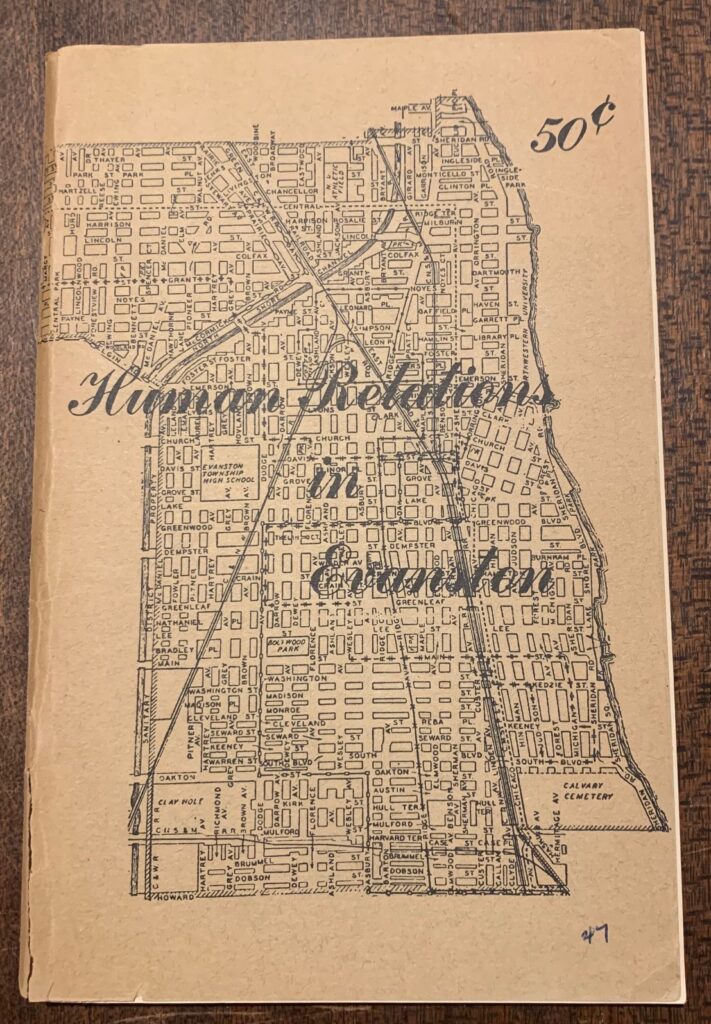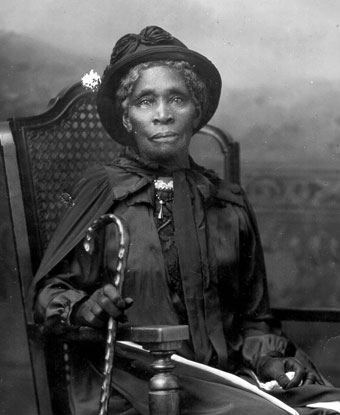By Sophia Weglarz, EWHP 2021 Summer Intern
In my previous blog post, I discussed the 1932 alliance between Evanston’s first Black alderman, Edwin Jourdain, and the first female alderwoman, Daisy Sandidge, when Sandidge ran for Jourdain’s unexpired term at his behest after he was removed for supposed election fraud. Earlier this summer, I wrote about the life of Maria Murray, Evanston’s first Black resident, whose 1845 arrival in Evanston is something of a mystery. Murray was brought here by Allen and Mary Vane, who bought her freedom and took her with them on their journey to the Midwest. Throughout Evanston’s history, instances like these of white allyship and connection to Evanston’s Black residents are in equal parts fascinating and perplexing.

My final look into this story takes place two decades after Sandidge and Jourdain, and nearly a century after Murray’s story, in October of 1953. That’s when the Evanston Interracial Council published its report Human Relations in Evanston detailing “the proceedings of the Inventory of Human Relations in Evanston held on May 9, 1953.”1 The report was edited by Homer A. Jack, Helen Montgomery, and Ruth Semmes. Jack, who was the president of the council, writes in the first few pages that the purpose of the inventory “was to obtain facts about the progress and status of minority group relations in Evanston.”2
Before this introduction, the report lists several “minority” organizations, ranging from Ebenezer A.M.E. Church to the Beth Emet Synagogue Sisterhood who were involved in the council and assisted with the inventory. Among these were a handful of Black women’s clubs, whose functions typically ranged from bolstering literacy to building solidarity for women’s issues in their communities. Several of the clubs listed, along many others not mentioned, can be found in the Evanston Women’s History Project’s database3 as well as in a few of the project’s blog posts tying these clubs to suffrage work.4
Many of these clubs were named after locally prominent Black club members, such as the Julia Gaston Club, and some were also linked to African-American churches.5 While I have worked on investigating the activities, members, and histories of these Black women’s clubs in summers past, there is one club in particular that has continually evaded my research: the Matilda Dunbar Club.
Looking back at my research from previous summers, I found a note written in my own handwriting saying “look into the Matilda Dunbar Club.” This summer, the Matilda Dunbar Club came up again as it was listed as one of the participants in the 1953 Inventory, but the report contains no mentions of the club beyond that. In fact, there is no record of the club online or in any of Evanston History Center’s records, including our archives, newspapers, and clipping files.

While we may not be able to find any records of the Matilda Dunbar Club, we can make a few conjectures about what the club’s purpose. First, its name offers a clue. Matilda Dunbar was the mother of famed Black writer Paul Laurence Dunbar. She was born into slavery in Kentucky in 1845. Dunbar had little to no educational opportunities while she was enslaved, but after she moved to Dayton, Ohio, following the separation from her first husband, she enrolled in night classes while working during the day, washing clothes, cooking, and sewing for Dayton residents.6 Dunbar taught her son, Paul, to read before he went to elementary school. Matilda, who was known throughout the neighborhood as “Mother Dunbar,” lived on Summit Street in Dayton, an overwhelmingly white area. When her son became a well-known author, she tended to his legacy and enjoyed showing his work to visitors until her death in 1934.7
From this, there are a few assumptions we can make from the choice to use Matilda’s name for the Evanston club’s name. For one, it might suggest that the Dunbar Club’s activities centered around literacy and motherhood, given Matilda’s biography. Also, while we know that the Dunbar Club was active in Evanston during the 1950s, we can also postulate that they were active starting sometime after her death in 1934.
Second, while there is little to no information about the Dunbar Club itself, there are few sources we can tap that can give some broad clues about its work. The Chicago Defender often chronicled the activities of Black women’s clubs in Chicago and the surrounding suburbs, primarily during the early 20th century, and is a great source for seeing how these club’s worked and what they were involved with.

Another key source is The Story of the Illinois Federation of Colored Women’s Clubs by Elizabeth Lindsay Davis, whose work documenting this history is largely responsible for providing us with what we know about Black women’s clubs in the state.8 Her book details many of Black women’s clubs across Illinois, giving more insight into what purpose the Matilda Dunbar Club, along with other Evanston Black women’s clubs, could have served.
Third, we can assume that the inclusion of the club in the 1953 report, alongside other Black women’s clubs like the Iroquois League (which we know much more about), means that the Dunbar Club likely began operations after the Great Migration and retained its prominence until the 1950s.9 The club’s inclusion in the Inventory also shows the lengths that the white establishment would now go (compared to earlier times) to create a sense of allyship with the minority community. But, like all the instances of allyship I’ve researched, this too would have been an imperfect kind, as the power imbalance between that of white and minority Evanstonians still presented insurmountable difficulties to forging true equality.
While I could not answer the question of what the Dunbar Club was, it remains an enticing story that still demands attention. Hopefully, through more investigation, the nuanced story that Black women’s clubs like the Matilda Dunbar Club present can be pieced together, along with the complimentary themes of white allyship, intersectionality, and solidarity (and where the inevitable difficulties and breakages occurred) that surface in the explorations of women’s history in Evanston.
[1] Jack, Homer A, et al. The Proceedings of the Inventory of Human Relations in Evanston Held on May 9, 1953. Evanston Interracial Council, 1953.
[2] Ibid
[3] Evanston Women’s History Project Database, https://evanstonwomen.org/project-database/.
[4] Sampson, Molly. “A Summer of Exploration.” Evanston Women’s History Project, 25 August 2019.
[5] Evanston Women’s History Project Database, The Julia Gaston Club, https://evanstonwomen.org/organization/julia-gaston-club/.
[6] “Matilda Burton Murphy Dunbar (U.S. National PARK SERVICE).” National Parks Service, U.S. Department of the Interior, www.nps.gov/people/matilda-burton-murphy-dunbar.htm.
[7] Ibid
[8] Davis, Elizabeth Lindsay, et al. The Story of the Illinois Federation of Colored Women’s Clubs. G.K. Hall, 1922. More about Davis can be found here – https://www.nps.gov/people/elizabeth-lindsay-davis.htm [1] Evanston Women’s History Project Database,
[9] The Julia Gaston Club, https://evanstonwomen.org/organization/julia-gaston-club/.
